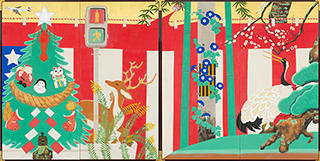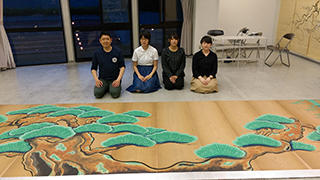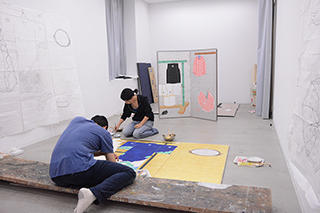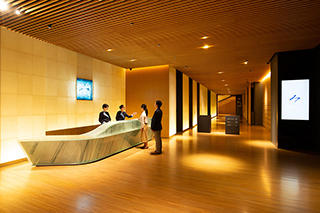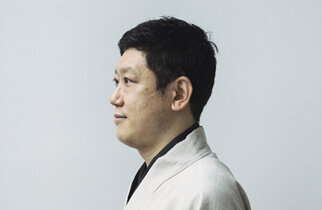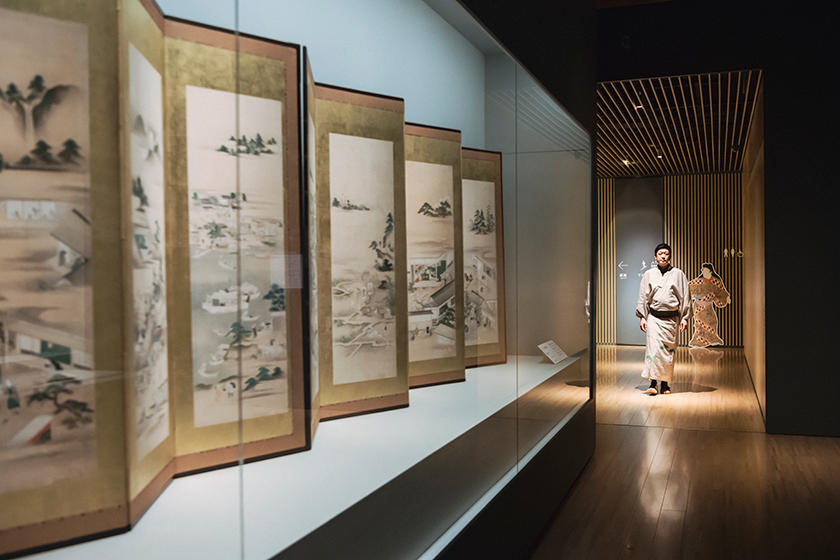
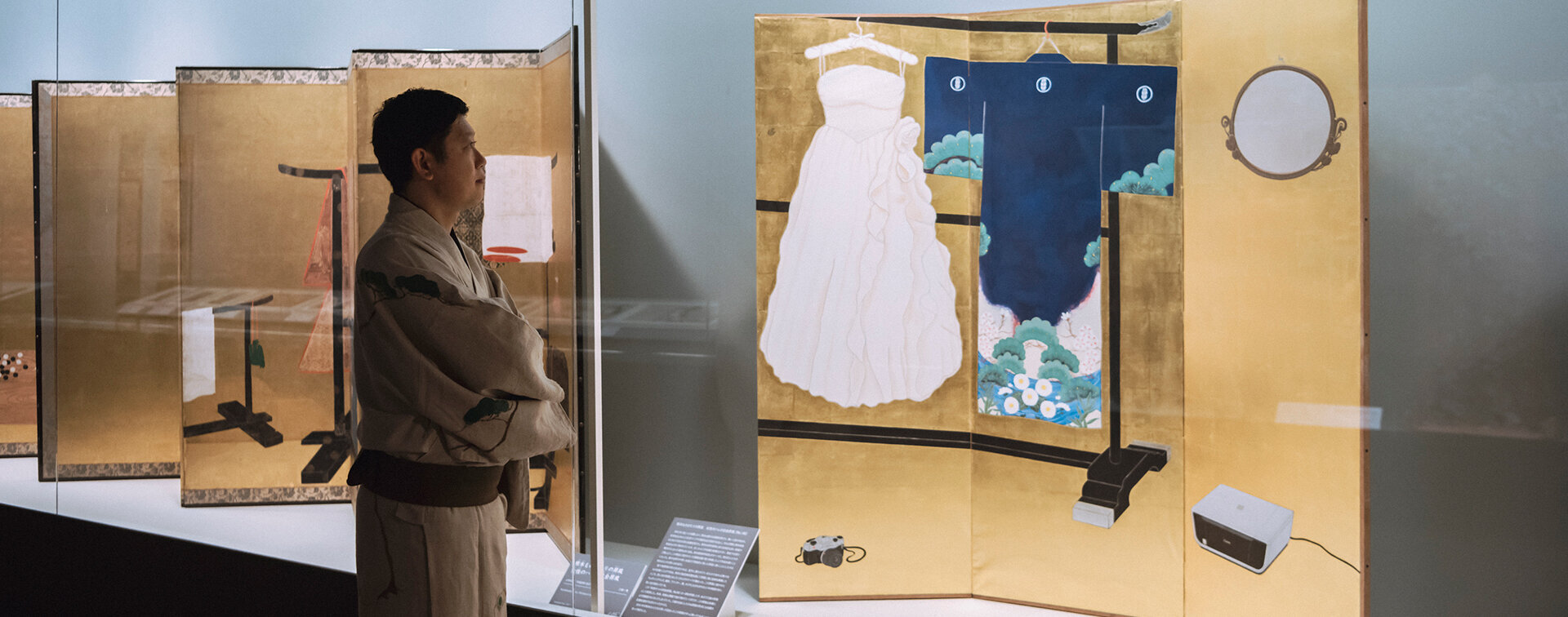

INTERVIEW
119
Taro YamamotoArtist
Enjoying "real-life art" in our lives
Different perspectives help us discover beauty
The traditional Japanese paintings by Taro Yamamoto exude undeniable boldness and fragility but also incorporate modern motifs that seem almost out of place. They are beautiful yet comical, very powerful, but heartachingly fragile. To discover how the eccentric world of Taro Yamamoto's "Nippon-Ga" paintings started, we met the artist at the newly renovated Suntory Museum of Art, where his artwork is exhibited. We asked him about his everyday perspective that generates adaptable ideas and art projects in different communities during the interview.
The way young Okinawans of my generation live opened my eyes to Japanese culture
"Mario and Luigi Folding Screen" and the rest of my artwork are created based on the concept of "Nippon-Ga," a blend of modern customs and classic Japanese paintings. I became interested in Japanese culture during my trip to Okinawa as I was studying to get into a university. I am generation "Dankai Junior," and it was nothing unusual for us to have 1 applicant out of 10 to get accepted into an art school. The ratio was 1 to 50 for Tokyo University of the Arts. I struggled to get into a school, and it took me 3 years to finally get accepted. Because things didn't go as planned, I was mentally trapped. A month before I took the entrance exam for the Okinawa Prefectural University of Arts, I unexplainably migrated to Okinawa with a tent on my back and walked the entire perimeter of the island while stopping to sleep.
Mario & Luigi Folding Screen Project 2015
To commemorate the 30th anniversary of the Super Mario Brothers and the 400th anniversary of Rimpa school, Mario and Luigi reimagined as Fujin and Raijin deities were painted as a project. The folding screen was displayed to the public during the exhibition of "The Road from Rimpa- Kamisaka Sekka and Yamamoto Taro" at Museum Eki Kyoto. After the exhibition, the woodblock prints by a woodblock publishing house, Unsodo, were produced.
"Mario & Luigi Folding Screen" ©Nintendo Taro Yamamoto 2015
Color painting on gold foil paper/two-panel folding screen/154.5cm x 169.8cm each
Nippon-Ga
Nippon-Ga is a byname for Yamamoto's artwork. While respecting the techniques and unique style of Japanese paintings, he incorporates characters from movies and video games or scenes from today to skillfully create artwork. He advocates his artwork under the name, Nippon-Ga, for its fun sound and international potential.
"Red and White Curtain of Four Seasons" 2009
Color painting on gold foil paper/two-panel folding screen/169cm x 167cm each
During my Okinawa trip, I realized many things. Okinawa has its own history and culture that are different from the mainland. I was inspired by how the young Okinawans respected their history and culture. It was around the time the bands and musicians came out with a modern take on Okinawan music. I was captivated by how they naturally and pridefully expressed their culture through music. The realization also made me wonder if we, the mainlanders, understand our culture and allured me towards Japanese culture.
Although my original plan was to go to an art university to study modern arts, the experience in Okinawa changed my plan and attracted me to traditional Japanese culture before the exam. I consequently decided to major in Japanese Painting. But to my disappointment, Japanese Painting taught in school was not what I hoped it to be. I regrettably turned into a not-so-studious student and began spending more time away from school with the Noh group. However, my time with the group ended up becoming the framework of what I do today. My encounter with the traditional culture that is not just paintings and my discovery of the "real-life Japanese culture" certainly made a significant impact on my life.
Noh-Play
While spending time with the Noh group, Yamamoto built a rapport with Hideo Kanze and Nobushige Kawamura. As a part of the Ultra Factory Project by Kyoto University of Art and Design, Yamamoto participated in "Yamamoto Nohgakudo's Portable Noh Stage Panel Creation Project" in 2016 and created a panel for the portable Noh stage for Yamamoto Nohgakudo of Osaka. The panel was completed and displayed to the public in 2017. With silver foil decorating the bottom, it justly embodies the expressions of Nippon-Ga.
My encounter with "real-life art" and my childhood experience that changed my life
Noh Plays incorporate real-life art from our daily lives like Shozoku (costumes). Folding screens, hanging scrolls, and fans, for example, are designed to be used at home, and adding drawings to them instinctively brings art closer to our lives. Western paintings are also meant for decorating homes. They initially served more as windows because they were much like photographs, capturing one scene from a single angle. On the other hand, Japanese paintings had no intentions to deliver the same effect. "Folding Screen with Design of Scenery in the Four Seasons," as an example, captures all four seasons, not just one scene. The positioning and angle of the folding screen and the positioning of where people sit can alter the way it is viewed. As it is not mean to be seen from a set angle, people need to move to view it. The sense of space and time that Western and Japanese paintings inherently possess are not the same.
I place great emphasis on the story when creating artwork. I know my stories for art are heavily influenced by Noh, but also by my childhood experience. My father was an eccentric man. He used to host unique study sessions at our home in my hometown of Kumamoto. A group of people assembled every month to talk about the same books they read. Looking back, I realized the group consisted of very famous scholars. There were writer Michiko Ishimure, historian Kyoji Watanabe, poet Hiromi Ito, to name a few. Following the study session was a party where alcohol was served. I used to hang out with them as a young boy, and they called an endearing name, "Taro-chan." When I was older, I still showed up at the party from time to time. Growing up in an environment like that, I was always interested in stories in one way or another.
I don't have the story for my artwork initially, but it develops as the artwork is being created. The first thing I do is to visit the place and talk to the locals. But, I am confronted by how little I know about the region and area. I learn the famous stories that all locals know about and the facts that are only told in the region. I can't go after all facts and stories. However, as I pursue them, the stories for my artwork come along naturally.
Japanese culture accepts diversity, and how diversity is accepted in Japan is very interesting. We have Halloween and Christmas and serve food from around the world at home. Children pick hamburger steaks as their favorite dish, and no one feels uncomfortable with it. Halloween is originally a celebration for children. But, the meaning of Halloween got lost and adults are enjoying it more than children in Japan. I think how Japan accepts different cultures while making modifications to them with a Japanese twist is interesting. But this trend is nothing new. We adopted Chinese characters but also invented hiragana and katakana. Instead of keeping the original Chinese reading, we gave it a different reading. It is like we input the data in an "OS" called "Japan," and the characters get corrupted. We, however, shrug it off and accept the corrupted characters. Japanese culture seems to have accepted diversity, but, in reality, it hasn't. It is very odd, but at the same time, amusing.

The excitement of something intangible being created through interactions with people
For my father's work, I spent 2 years before elementary school in the US and 1 year from the winter of my 4th grade in Sweden. But the truth is, I don't know how much of that experience influenced me to be who I am today. I grew up with 3 brothers, but I am the only one who works in the field of Japanese art. Based on that, I figured that the overseas experience during childhood hasn't necessarily influenced my life. If anything, the only influence that experience had on me is the lingering sentiment that I will have to leave behind everything that I grew familiar with.
A kindergartener in Japan was suddenly taken to the US without an explanation. When he felt comfortable being somewhat Americanized, he was brought back to Japan. Then one day again, when he was finally acclimated to living in Japan, he was told that the family was moving to Sweden this time. Because the internet wasn't readily available and sending letters via Air Mail was challenging for an elementary school child, moving meant saying good-bye to my friends and place I knew. I think it is my nature to want to get involved with small towns and neighborhoods and create deep ties with the communities. As my upbringing compelled me to take a step back, my yearning to establish relationships with people and place grew bigger with time.
2006's "Nippon-Ga Byobu Matsuri" in Kyoto was my first project for which I worked with the people in the community. July is the month of the Gion Matsuri Festival, and for a month, festivals and events follow. Around the Yamahoko Junko Procession, it is customary for the neighborhood of Hokomachi to display their folding screens, hanging scrolls, flower vases, or other treasures inherited within the family, outside their doors and show them off. Those are art pieces that are worth being exhibited at an art museum. However, they are openly displayed in the most prominent places of Machiya. It is as if "the real art" is displayed in our everyday lives as it meant to be. It blends in the ambiance of the streets in the most pleasing way. I used to be a viewer of "the real art", but my desire to do it "the Taro Yamamoto way" led me to launch "Nippon-Ga Byobu Matsuri." But for a young artist to get connected with the locals with no prior relationship was not easy. So, I visited the temples, kimono shops, galleries, KFC, and other establishments individually with my supporters to ask them if I could use their venue to exhibit my work. Through the process of interacting with people, I felt the excitement of creating something that wasn't art pieces. After the project, my past teaching experience at an art school in Akita led me to take part in planning art festivals, including "KAMIKOANI Project Akita" and "Neo Classic! Kakunodate" as well as events with the locals in different regions of Akita. I became more captivated by the charms that didn't exist in the process of creating art pieces.
The folding screens that tell the local tales
Among the regional projects I took part in, "Kumamoto Monogatari no Byobu Project" in my hometown of Kumamoto was an experience that left a big impression on me. As we speak, Kumamoto is recovering from the flood damage. But, when we worked on the project in 2016, Kumamoto was struck by earthquakes that devasted the region. I realized artists who create artwork were at a disadvantage because we couldn't respond quickly enough to offer aid, whereas musicians could rush to the scene to perform charity concerts. Creating artwork is time-consuming. So, while I was feeling the limitation, a local architect who graduated from the same high school as me, but a few years earlier approached me with a redeeming opportunity. Because he did renovation work primarily on old homes, I acquired folding screens from an old mounting material shop he knew. The shop, which unfortunately had to close down later, gave us the screens they were going to dispose of. I launched the project to restore the screens with students of Kyoto University of the Arts (today Kyoto University of Art and Design). For the process of choosing the designs, we asked the citizens of Kumamoto to submit the names and stories of the items that were unique to the region.
Kumamoto "Monogatari no Byobu Project"
"Morimoto Fusuma Hyogu Zairyo Ten" sold fusuma screens and mounting materials for over a century. But unfortunately, they went out of business after being affected by the Kumamoto earthquakes. Yamamoto and students from Kyoto University of Art and Design restored the folding screens inherited from the shop as a part of the project. The general public in Kumamoto submitted design ideas and memorable stories, and the selected ideas were beautifully depicted onto the restored screens in the style of "Tagasode Byobu."
Currently being displayed at "ART in LIFE, LIFE and BEAUTY," the first exhibition to celebrate the reopening of the Suntory Museum of Art, are the artwork I created in Kumamoto. It is a "Tagasode Byobu" screen with various kimonos hanging from the "Iko" clothes rack. It accurately exudes the mood of life from the Edo period. I personally want the visitors to decipher the story of the screen by imagining the type of people who wore the kimonos, the kind of life they had, the reason one kimono is on the floor, but not the others, and so on. Life is comprised of ordinary days, but it is also a combination of little stories of individual people. The visitors will maximize their experience at the exhibition if they ruminate on what each motif means or represents.
Reopening Celebration Exhibition I "ART in LIFE, LIFE and BEAUTY"
"ART in LIFE, LIFE and BEAUTY" is held to commemorate the Suntory Museum of Art's reopening. Going back to the museum's basic principle, they carefully selected some of the most beautiful masterpieces, including party furniture, special occasion kimonos and accessories, opulent makeup boxes, items with exotic designs, and other items that accessorized people's lives back in the day. A special collection provided by the Suntory Museum of Art is displayed with the antique arts created by today's modern artists, including Yamamoto. The last day of the exhibition is Sunday, September 13, 2020 (the schedule is subject to change).
Photographed: National Treasure Box with Fusenryo Design in Mother-of-Pearl Inlay and Maki-e/Suntory Museum of Art
The Suntory Museum of Art
After opening its door in 1961, the Suntory Museum of Art relocated to Tokyo Midtown in 2007. Under the basic principle of "Beauty in Life," the museum houses some 3,000 items, including antique Japanese art pieces. The renovation design of the new museum was entrusted to the architect, Kengo Kuma. To create the feel of "an urban living room," the museum features symbolic vertical lattice designs and floors made of recycled whiskey barrels. Renovated and reopened in July 2020, the museum upgraded the exhibition facilities. It also underwent a complete renovation, including the entrance area, under the supervision of Kengo Kuma.
Photo:© Tatsuyuki Tayama
The perception that views the layers of time and history, and the perception that accepts cultural diversity
I personally think that the Coronavirus catastrophe made me see everyday scenes more clearly. Cherry trees had fully blossomed when the state of emergency was declared. One day, I was out strolling. While our lives changed, nothing about the natural phenomenon changed; the cherry trees blossomed, shed their petals, and stripped down to their leaves. Nature wasn't the only thing that didn't change. The traffic lights kept flashing unwaveringly, and the traffic signs remained standing in their righteous places. I was able to notice things that changed and didn't change more clearly.
I could sense things through vision, but truthfully, I don't know what perspective I usually use to see things. More precisely, I don't acknowledge that my perspectives are particularly different from others. One thing I know is that I have two different perspectives. The first one is the one I use to view layers of time and history, like old Japanese tradition. That includes things that remain unchanged or grow more refined with time and the modern things that change with time. The other perception is the one that accepts cultural diversity.
I currently live in Kyoto, and the city is filled with similar scenes. While some historical temples and shrines undergo repairs and change, the ambiance remains the same. Kyoto is where history and tradition are deeply embedded. Still, our days are revolved around going to convenience stores and eating fast food. It is amusing how two different facets merge and manifest themselves as a normal life. I often pair unlike items for my work, like a pine tree with a traffic signal, a cherry blossom tree with a US flag. Sometimes older people point out that a traffic signal should not be placed next to a pine tree. But those odd combinations are nothing out of the ordinary in our lives. They might not sound ideal at first, but how they are drawn can make the pair surprisingly attractive. Looking at an ordinary scene from a perspective like mine will make everything more amusing.

From the museum to the ordinary world outside: Extended art
There is one more thing I discovered amid the Coronavirus catastrophe. After self-restraint was ordered, theater plays were canceled. It was inevitable for the people in that field to lose their income. At the beginning of March, the Kyogen comedians from the Shigeyama Sengoroke school in Kyoto decided they would stream a comedy series, "YouTube de Aimasho." They made a very casual announcement on social media; because they were "out of work," they were starting the project, but for free! The series is amazingly outrageous. Initially, they met up at the theater where they practiced. But because they had to stop going to places voluntarily, it became harder to meet up. At one point, some comedians started to take part in it via Zoom. One thing led to another, they decided the ones who could come to the theater would do the acting only while the ones who could join via Zoom would do the voice only. That is when "the Voice-Over Kyogen" started. I know a few people my age from the Shigeyama Sengoroke school, and their comedians are goofy in a positive way. Kyogen being a traditional theatrical art, things are supposed to be fixed and set. However, the comedians in charge of voice improvise the scripts that have nothing to do with the "kata" movement and drive the actors-with-no-voice crazy. I was very entertained by the unprecedented turnout of the play.
I was also delighted when I found out that the audience can get involved and have fun using the chat function. When people with little knowledge watch Kyogen in a theater, they have no choice but to keep watching even if they couldn't catch what was being said. But Kyogen on YouTube enables the viewers to type questions like "what does it mean?" and the Kyogen connoisseurs answer them. Even some Kyogen comedians who aren't performing in the skit end up joining the chat, and the comedians from the same group point out when the performers mess up. This approach brought a new way of enjoying the traditional theatrical art for both the performers and the viewers.
I once made a guest appearance in the series and, one thing led to another, I agreed to design and sell T-shirts for "YouTube de Aimasho" with students. My goal wasn't about the T-shirts being delivered to the viewers, but it was about the viewers wearing the T-shirts out in town. It may just be a design for T-shirts, but the process of creating the T-shirt, to a certain extent, is art. This project was launched online on social media and YouTube. But it will ultimately reach more people offline as the T-shirts hit the streets. The diversified ways the project reaches out to people is fascinating. Before I knew, the whole process grew into a sizeable project. At no point was this intentional. But, this new form of traditional entertainment was an outcome of a natural progression of us being curious and exploring what was happening. I am very hopeful that this type of accidental artistic connection and development will continue to be created.
"YouTube de Aimasho" T-shirt
"YouTube de Aimasho" was launched by the Shigeyama Sengoroke school with hopes that people would grow more familiarized with Kyogen and the comedy. Yamamoto, who has ties with the school, collaborated with the students of Kyoto University of Art and Design and designed the program's original T-shirts. The final product has a more contemporary look of the "daruma and mimizuku" design that the school often uses for their shozoku costumes.
It is important for me that the art gets out to the streets. Have you ever walked out of the movie theater with a renewed perspective? For example, a man after watching a Bruce Lee movie is bound to turn into Bruce Lee. When Frozen was big, I remember seeing a girl around the age of 4 walking out of the bathroom stall next to me singing and impersonating Elsa. That was most likely because she had a new perspective. Similarly, after looking at "Tagasode Byobu" at the Suntory Museum of Art, a person returns home to their cluttered unflattering room and has a renewed sense that their room is indeed a lovely space. The artwork is interesting as it can alter people's perception. It can change a mediocre view to an impressive view and an ordinary view to a remarkable view. With that said, I would love to get the whole community involved and do a tour-exhibition similar to "the Nippon-Ga Byobu Festival" in Tokyo or other big cities one day.
Editor's Thoughts
I was reminded that a straight, untainted perception leads to some of the most extraordinary ideas and the ability to capture subtle scenes. While Mr. Yamamoto is entertained by what is happening in front of him, he also values the ties he builds with others. His stories were full of humor and made the interview full of laughter. (text_akiko_miyaura)
RANKING
ALL
CATEGORY





